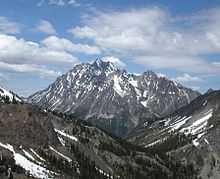Wenatchee Mountains
| Wenatchee Mountains | |
|---|---|
 | |
| Highest point | |
| Peak | Mount Stuart |
| Elevation | 9,415 ft (2,870 m) |
| Coordinates | 47°28′30.5″N 120°54′08.6″W / 47.475139°N 120.902389°WCoordinates: 47°28′30.5″N 120°54′08.6″W / 47.475139°N 120.902389°W |
| Dimensions | |
| Length | 50 mi (80 km) east-west |
| Geography | |
|
<div style="padding:2px 2px 2px 2px;>  | |
| Country | United States |
| State | Washington |
| Counties | Chelan and Kittitas |
.jpg)
The Wenatchee Mountains are a range of mountains in central Washington State, United States of America. A major subrange of the Cascade Range, extending east 50 miles (80 km) from the Cascade crest, the Wenatchee Mountains separate the drainage basins of the Yakima River from the Wenatchee River.[1] The crest of the range forms part of the boundary between Chelan and Kittitas Counties.
Extent
Fred Beckey describes the Wenatchee Mountains as the area between the Wenatchee and Yakima rivers and Stevens Pass. Among the range's significant features he describes are Mount Stuart, the second highest non-volcanic peak in Washington and one of the largest single granitic mountains in the United States, the Cashmere Crags, the Lost World Plateau, Edward Plateau, and Dragontail Plateau, the Enchantment Lakes Basin ("one of the most marvelous examples of an ice-sculpted wilderness in the Cascade Range), Icicle Creek and its narrow, U-shaped valley over 6,000 feet (1,800 m) deep, one of the deepest in the Cascades, and the Wenatchee River's unusual winding Tumwater Canyon gorge.[1]
According to Peakbagger.com the Wenatchee Mountains are defined as bounded by U.S. Route 2 from Stevens Pass to Wenatchee on the Columbia River, then down the Columbia River to Interstate 90, then west along the highway to the vicinity of Cle Elum and Roslyn, then north along Cle Elum Lake and the Cle Elum River and north to Stevens Pass.[2] Subranges of the Wenatchee Mountains and their highest peaks as defined by Peakbagger.com are the Chiwaukum Mountains (Big Chiwaukum Mountain, 8,501 feet (2,591 m)), North Wenatchee Mountains (Cashmere Mountain, 8,501 feet (2,591 m)), Stuart Range (Mount Stuart, 9,415 feet (2,870 m)), the Teanaway Area (Ingalls Peak, 7,662 feet (2,335 m)), and the Mission-Naneum Ridges (Mission Peak, 6,876 feet (2,096 m)).[2] Peakbagger.com also defines and names the mountain regions bordering the Wenatchee Mountains. These are the Alpine Lakes Area to the west, South Cascade Crest to the south, Glacier Peak-North Stevens Pass area to the northwest, and the Entiat Mountains to the northeast.[2]
The USGS GNIS defines the range with a simple list seven points in a line, running from approximately Paddy-Go-Easy Pass and Granite Mountain to approximately Blewett Pass and Naneum Creek.[3]
Major Peaks

Partial list of peaks:
- Mount Stuart - 9,415 feet (2,870 m)
- Dragontail Peak - 8,840 feet (2,690 m)
- Colchuck Peak - 8,705 feet (2,653 m)
- Cannon Mountain - 8,638 feet (2,633 m)
- Sherpa Peak - 8,605 feet (2,623 m)
- Enchantment Peak - 8,520 feet (2,600 m)
- Witches Tower - 8,520 feet (2,600 m)
- Cashmere Mountain - 8,501 feet (2,591 m)
- Argonaut Peak - 8,453 feet (2,576 m)
- Little Annapurna - 8,440 feet (2,570 m)
- Eightmile Mountain - 7,996 feet (2,437 m)
- The Cradle - 7,467 feet (2,276 m)
- Granite Mountain - 7,144 feet (2,177 m)
- Mac Peak - 6,859 feet (2,091 m)
- Thunder Mountain Lakes Peak - 6,711 feet (2,046 m)
- Trico Mountain - 6,640 feet (2,020 m)
- Thunder Mountain - 6,556 feet (1,998 m)
- Slippery Slab Tower - 6,356 feet (1,937 m)
Natural history
The Wenatchee Mountains are in the rain shadow of the main Cascade Range and hence are drier and have fewer trees. This comparative lack of trees offers good wildflower displays and wide views. Serpentine soils are found within the Wenatchee Mountains, modifying the plant communities in those areas.[4]
The Wenatchee Mountains are home to a number of rare, endemic, or disjunct plant species, including Androsace nivalis var. dentata, Claytonia megarhiza var. nivalis, Delphinium viridescens, Lewisiopsis tweedyi, Trifolium thompsonii, and Valeriana columbiana.[4] The Wenatchee Mountains checkermallow (Sidalcea oregano var. calva) occurs only along Peshastin Creek, south of Leavenworth, Washington. It is the rarest plant in Washington, and is now on the endangered species list.
See also
References
- ↑ 1.0 1.1 Beckey, Fred (2000). Cascade Alpine Guide: Climbing and High Routes: Columbia River to Stevens Pass (3rd ed.). The Mountaineers. pp. 233–238. ISBN 978-0-89886-577-6.
- ↑ 2.0 2.1 2.2 "Wenatchee Mountains". Peakbagger.com. Retrieved 9 August 2009.
- ↑ U.S. Geological Survey Geographic Names Information System: Wenatchee Mountains
- ↑ 4.0 4.1 Kruckeberg, Arthur; Leuthy, Coleman (Summer 1991). "The Wenatchee Mountains" (PDF). Bulletin of the American Rock Garden Society 49 (3): 162–168.
External links
| Wikimedia Commons has media related to Wenatchee Mountains. |